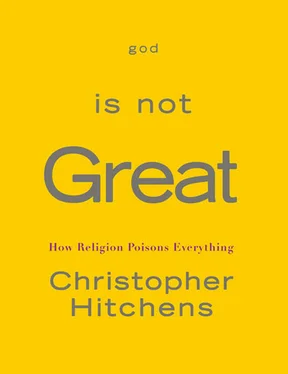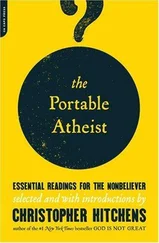IN THE CITY OF JERUSALEM, there is a special ward in the mental hospital for those who represent a special danger to themselves and others. These deluded patients are the sufferers from the “Jerusalem syndrome.” Police and security officers are trained to recognize them, though their mania is often concealed behind a mask of deceptively beatific calm. They have come to the holy city in order to announce themselves as the Messiah or redeemer, or to proclaim the end of days. The connection between religious faith and mental disorder is, from the viewpoint of the tolerant and the “multicultural,” both very obvious and highly unmentionable. If someone murders his children and then says that god ordered him to do it, we might find him not guilty by reason of insanity but he would be incarcerated nonetheless. If someone lives in a cave and claims to be seeing visions and experiencing prophetic dreams, we may leave him alone until he turns out to be planning, in a nonphantasmal way, the joy of suicide bombing. If someone announces himself to be god’s anointed, and begins stockpiling Kool-Aid and weapons and helping himself to the wives and daughters of his acolytes, we raise a bit more than a skeptical eyebrow. But if these things can be preached under the protection of an established religion, we are expected to take them at face value. All three monotheisms, just to take the most salient example, praise Abraham for being willing to hear voices and then to take his son Isaac for a long and rather mad and gloomy walk. And then the caprice by which his murderous hand is finally stayed is written down as divine mercy.
The relationship between physical health and mental health is now well understood to have a strong connection to the sexual function, or dysfunction. Can it be a coincidence, then, that all religions claim the right to legislate in matters of sex? The principal way in which believers inflict on themselves, on each other, and on nonbelievers, has always been their claim to monopoly in this sphere. Most religions (with the exception of the few cults that actually permit or encourage it) do not have to bother much with enforcing the taboo on incest. Like murder and theft, this is usually found to be abhorrent to humans without any further explanation. But merely to survey the history of sexual dread and proscription, as codified by religion, is to be met with a very disturbing connection between extreme prurience and extreme repression. Almost every sexual impulse has been made the occasion for prohibition, guilt, and shame. Manual sex, oral sex, anal sex, non–missionary position sex: to name it is to discover a fearsome ban upon it. Even in modern and hedonistic America, several states legally define “sodomy” as that which is not directed at face-to-face heterosexual procreation.
This raises gigantic objections to the argument from “design,” whether we choose to call that design “intelligent” or not. Clearly, the human species is designed to experiment with sex. No less clearly, this fact is well-known to the priesthoods. When Dr. Samuel Johnson had completed the first real dictionary of the English language, he was visited by a delegation of respectable old ladies who wished to congratulate him for not including any indecent words. His response—which was that he was interested to see that the ladies had been looking them up—contains almost all that needs to be said on this point. Orthodox Jews conduct congress by means of a hole in the sheet, and subject their women to ritual baths to cleanse the stain of menstruation. Muslims subject adulterers to public lashings with a whip. Christians used to lick their lips while examining women for signs of witchcraft. I need not go on in this vein: any reader of this book will know of a vivid example, or will simply guess my meaning.
A consistent proof that religion is man-made and anthropomorphic can also be found in the fact that it is usually “man” made, in the sense of masculine, as well. The holy book in the longest continuous use—the Talmud—commands the observant one to thank his maker every day that he was not born a woman. (This raises again the insistent question: who but a slave thanks his master for what his master has decided to do without bothering to consult him?) The Old Testament, as Christians condescendingly call it, has woman cloned from man for his use and comfort. The New Testament has Saint Paul expressing both fear and contempt for the female. Throughout all religious texts, there is a primitive fear that half the human race is simultaneously defiled and unclean, and yet is also a temptation to sin that is impossible to resist. Perhaps this explains the hysterical cult of virginity and of a Virgin, and the dread of the female form and of female reproductive functions? And there may be someone who can explain the sexual and other cruelties of the religious without any reference to the obsession with celibacy, but that someone will not be me. I simply laugh when I read the Koran, with its endless prohibitions on sex and its corrupt promise of infinite debauchery in the life to come: it is like seeing through the “let’s pretend” of a child, but without the indulgence that comes from watching the innocent at play. The homicidal lunatics—rehearsing to be genocidal lunatics—of 9/11 were perhaps tempted by virgins, but it is far more revolting to contemplate that, like so many of their fellow jihadists, they were virgins. Like monks of old, the fanatics are taken early from their families, taught to despise their mothers and sisters, and come to adulthood without ever having had a normal conversation, let alone a normal relationship, with a woman. This is disease by definition. Christianity is too repressed to offer sex in paradise—indeed it has never been able to evolve a tempting heaven at all—but it has been lavish in its promise of sadistic and everlasting punishment for sexual backsliders, which is nearly as revealing in making the same point in a different way.
ASPECIAL SUBGENRE of modern literature is the memoir of a man or woman who once underwent a religious education. The modern world is now sufficiently secular for some of these authors to attempt to be funny about what they underwent, and what they were expected to believe. However, such books tend necessarily to be written by those with enough fortitude to have survived the experience. We have no way to quantify the damage done by telling tens of millions of children that masturbation will make them blind, or that impure thoughts will lead to an eternity of torment, or that members of other faiths including members of their own families will burn, or that venereal disease will result from kisses. Nor can we hope to quantify the damage done by holy instructors who rammed home these lies and accompanied them with floggings and rapes and public humiliations. Some of those who “rest in unvisited tombs” may have contributed to the good of the world, but those who preached hatred and fear and guilt and who ruined innumerable childhoods should have been thankful that the hell they preached was only one among their wicked falsifications, and that they were not sent to rot there.
VIOLENT, IRRATIONAL, INTOLERANT, allied to racism and tribalism and bigotry, invested in ignorance and hostile to free inquiry, contemptuous of women and coercive toward children: organized religion ought to have a great deal on its conscience. There is one more charge to be added to the bill of indictment. With a necessary part of its collective mind, religion looks forward to the destruction of the world. By this I do not mean it “looks forward” in the purely eschatological sense of anticipating the end. I mean, rather, that it openly or covertly wishes that end to occur. Perhaps half aware that its unsupported arguments are not entirely persuasive, and perhaps uneasy about its own greedy accumulation of temporal power and wealth, religion has never ceased to proclaim the Apocalypse and the day of judgment. This has been a constant trope, ever since the first witch doctors and shamans learned to predict eclipses and to use their half-baked celestial knowledge to terrify the ignorant. It stretches from the epistles of Saint Paul, who clearly thought and hoped that time was running out for humanity, through the deranged fantasies of the book of Revelation, which were at least memorably written by the alleged Saint John the Divine on the Greek island of Patmos, to the best-selling pulp-fiction Left Behind series, which, ostensibly “authored” by Tim LaHaye and Jerry B. Jenkins, was apparently generated by the old expedient of letting two orangutans loose on a word processor:
Читать дальше












